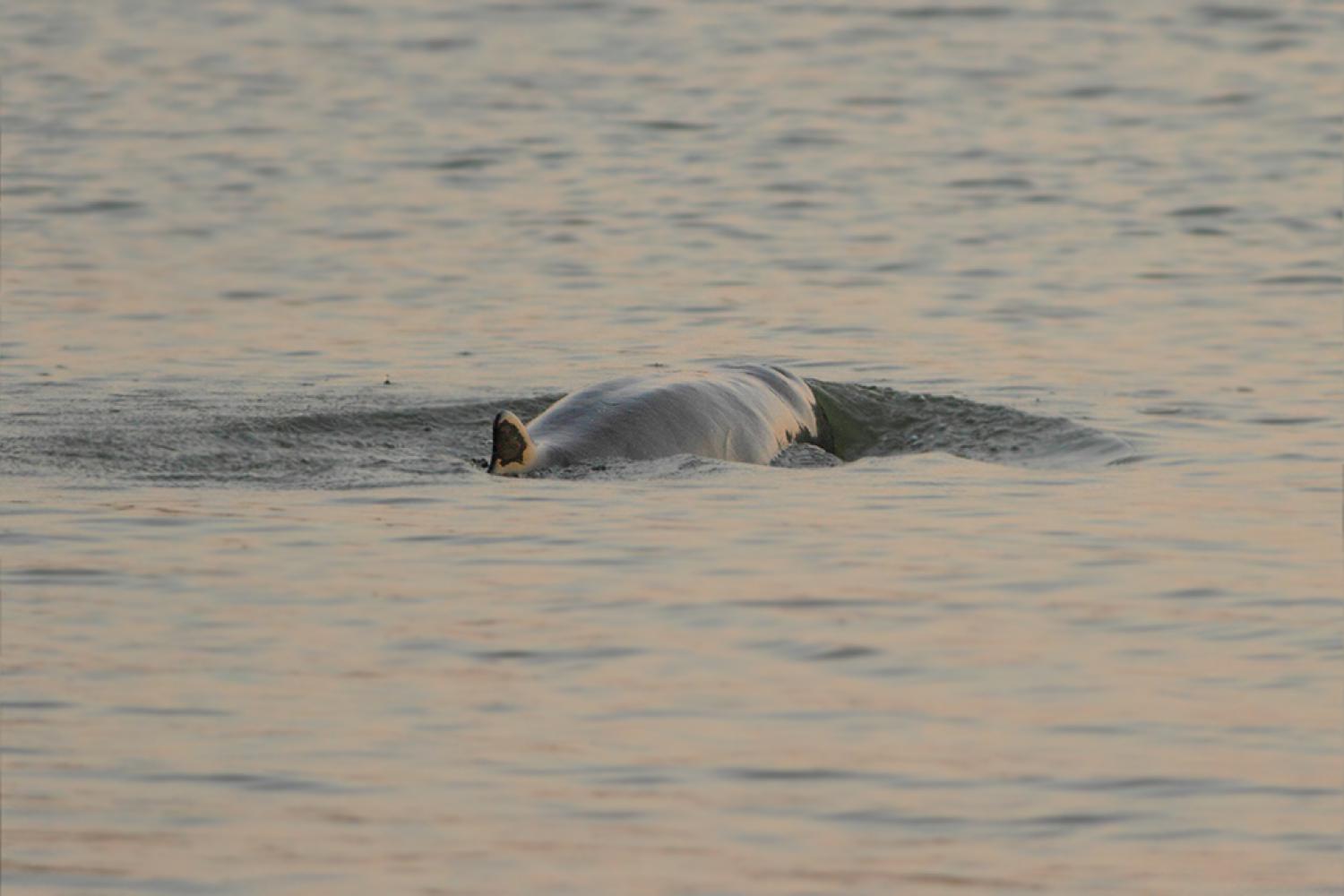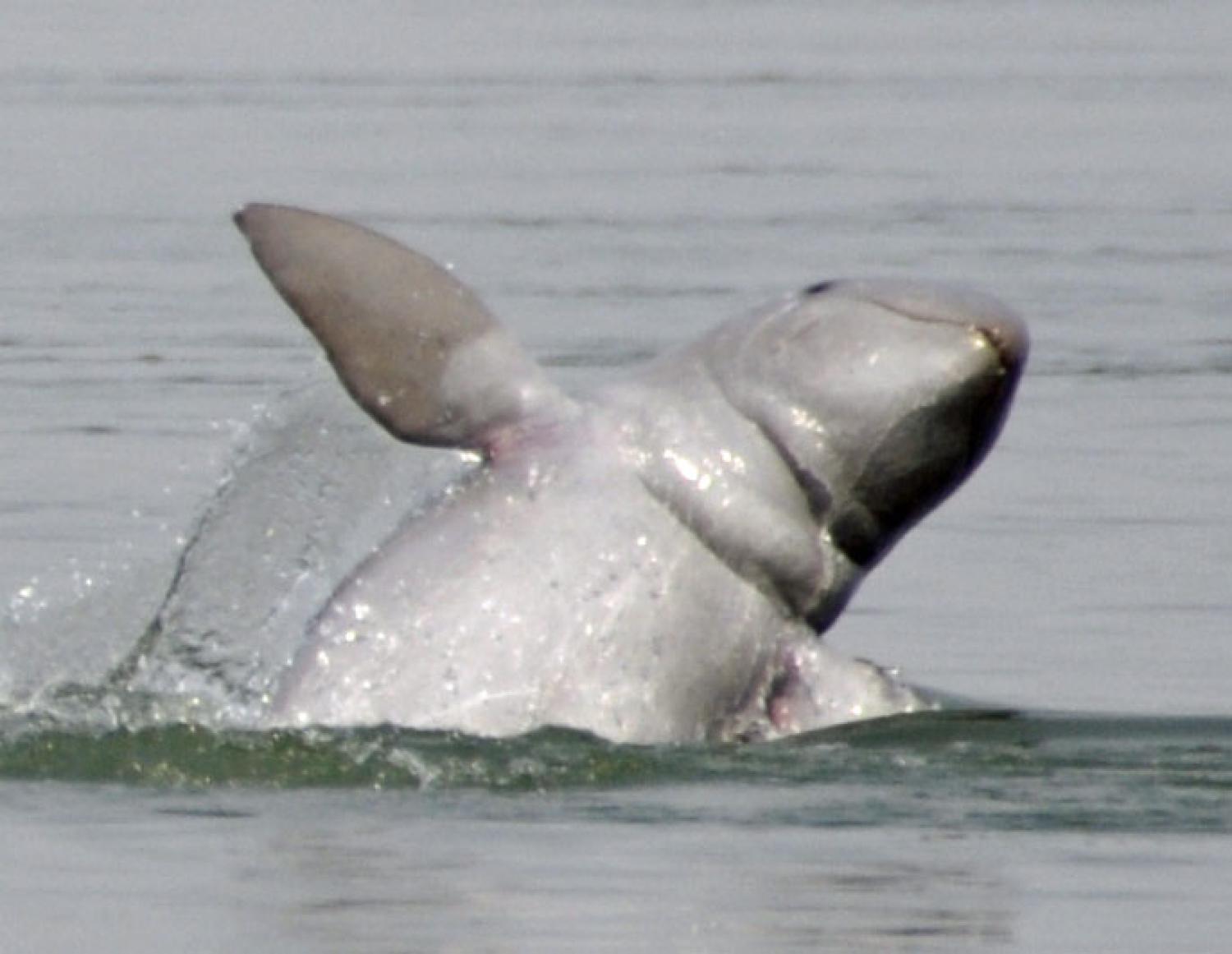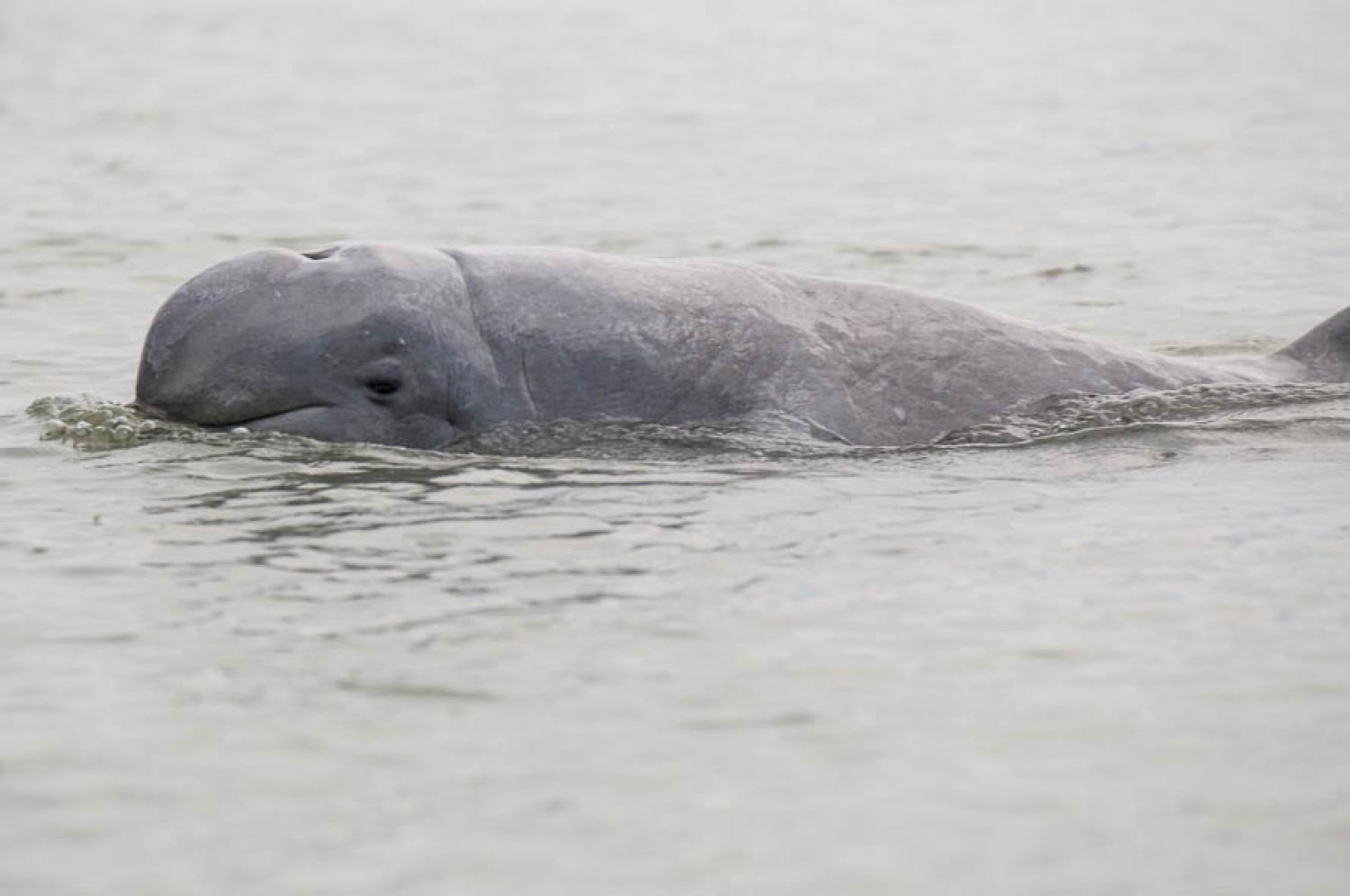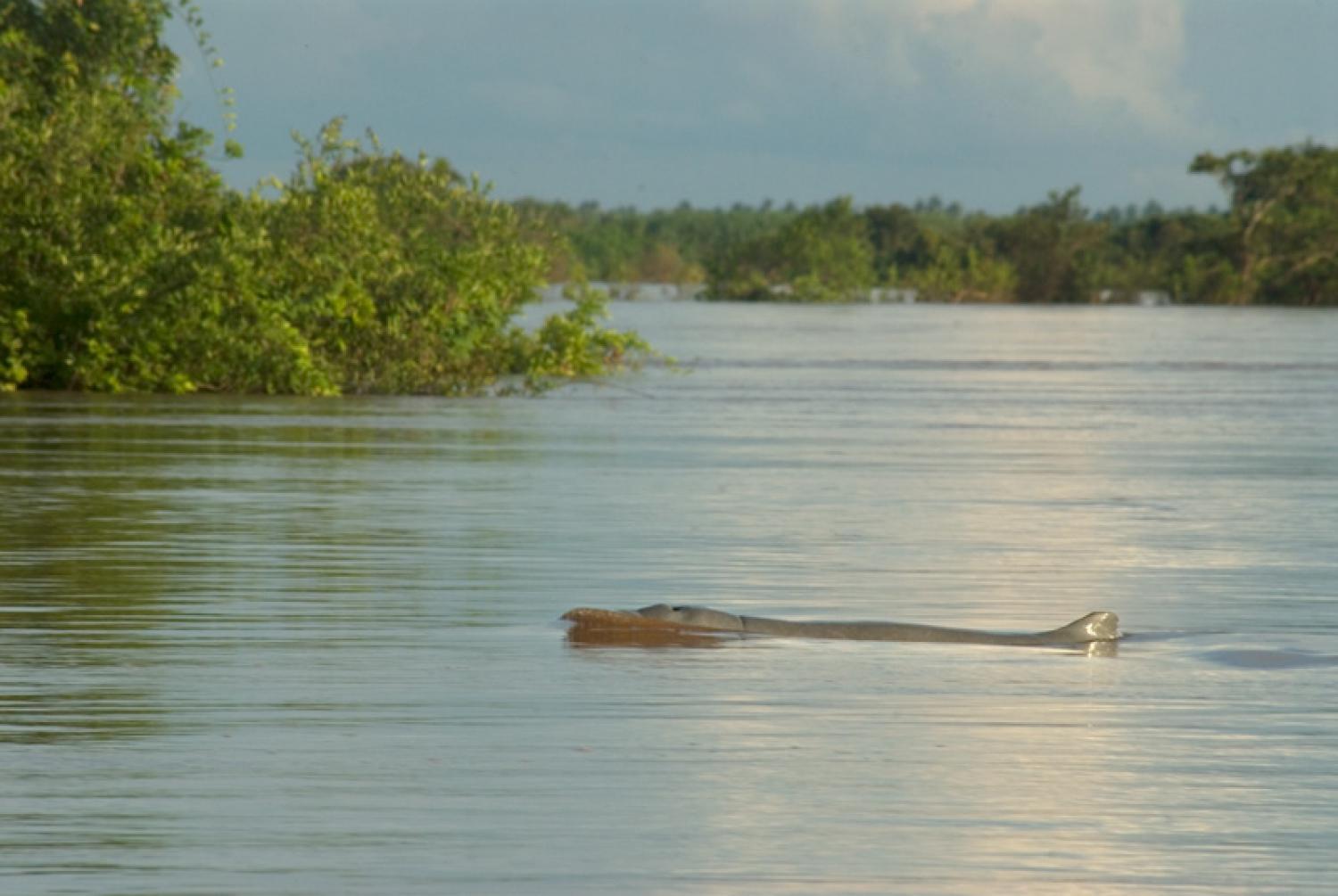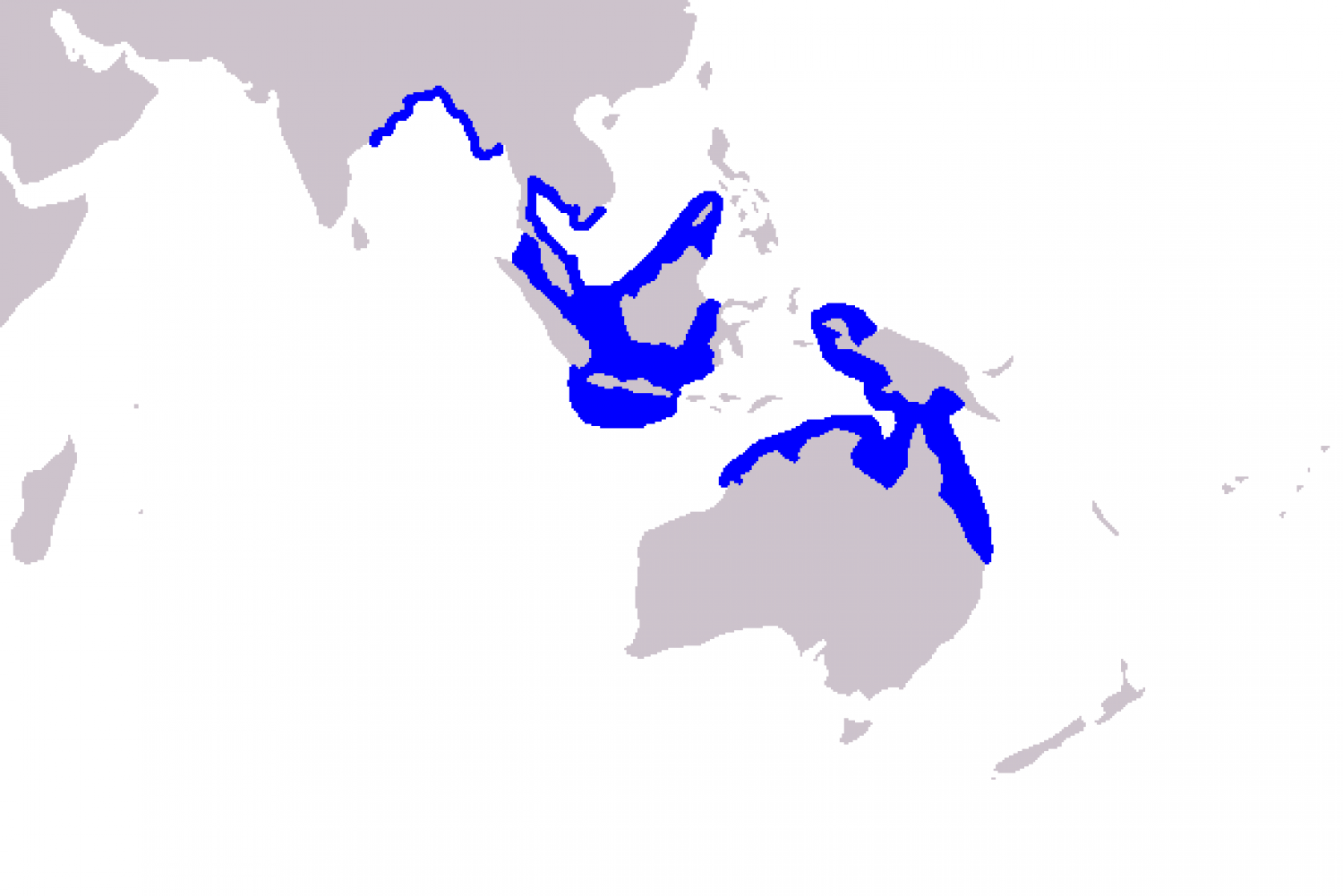Species of Thailand
Irrawaddy dolphin
Orcaella brevirostris
Richard Owen in John Edward Gray, 1866
The Irrawaddy dolphin (Orcaella brevirostris) is a euryhaline species of oceanic dolphin found in discontinuous subpopulations near sea coasts and in estuaries and rivers in parts of the Bay of Bengal and Southeast Asia.
Etymology and taxonomic history
One of the earliest recorded descriptions of the Irrawaddy dolphin was by Sir Richard Owen in 1866 based on a specimen found in 1852, in the harbour of Visakhapatnam on the east coast of India. It is one of two species in its genus. It has sometimes been listed variously in a family containing just itself and in Monodontidae and in Delphinapteridae. There is now widespread agreement to list it in the Delphinidae family.
Genetically, the Irrawaddy dolphin is closely related to the killer whale (orca). It is also closely related to the Australian snubfin dolphin, and these two were only recently recognised as distinct species. The species name brevirostris comes from the Latin meaning short-beaked. In 2005, genetic analysis showed the Australian snubfin dolphin found at the coast of northern Australia forms a second species in the Orcaella genus.
Overall, the dolphins' colour is grey to dark slate blue, paler underneath, with no distinctive pattern. The dorsal fin is small and rounded behind the middle of the back. The forehead is high and rounded; the beak is lacking. The front of its snout is sort of blunt. The flippers are broad and rounded. The species found in Borneo, the finless porpoise, Neophocaena phocaenoides, is similar and has no back fin; the humpback dolphin, Sousa chinensis, is larger, has a longer beak and a larger dorsal fin.
Vernacular names for O. brevirostris include the following:
- Chilika dialect: baslnyya magar or ଭୂଆଷୁଣୀ ମଗର bhuasuni magar (lit. oil-yielding dolphin)
- Filipino: lampasut
- Bangladesh: shushuko
- Indonesian: pesut
- Khmer: ផ្សោត ph’sout
- Lao: ປາຂ່າ pha’ka
- Malay: dolphin empesut
- Odia: ଖେମ khem or ଖେରା khera
- Thai: โลมาอิรวดี pla loma hua bat ("alms-bowl dolphin", due to the shape of their heads)
Description
The Irrawaddy dolphin is similar to the beluga in appearance, though most closely related to the killer whale. It has a large melon and a blunt, rounded head, and the beak is indistinct. The dorsal fin, located about two-thirds posterior along the back, is short, blunt, and triangular. The flippers are long and broad. It is lightly coloured all over, but slightly more white on the underside than the back. Unlike any other dolphin, the Irrawaddy's u-shaped blowhole is placed on the left of the midline and opens towards the front of the dolphin. Their short beaks appear very different than those of other dolphins, and their mouths are known for having 12-19 peg-like teeth on each sides of their jaws. Irrawaddys can range from 90 kg to 200 kg and length is 2.3 m at full maturity. Maximum recorded length is 2.75 m of a male from Thailand.
Reproduction
These dolphins are thought to reach sexual maturity at seven to nine years. In the Northern Hemisphere, mating is reported from December to June. Its gestation period is 14 months; cows give birth to a single calf every two to three years. Length is about 1 m at birth. Birth weight is about 10 kg. Weaning is after two years. Lifespan is about 30 years.
Behaviour
Communication is carried out with clicks, creaks, and buzzes at a dominant frequency of about 60 kilohertz, which is thought to be used for echolocation. Bony fish and fish eggs, cephalopods, and crustaceans are taken as food. Observations of captive animals indicate food may be taken into the mouth by suction. Irrawaddy dolphins are capable of squirting streams of water that can reach up to 1.5 m; this distinct behavior has been known for herding fish into general area for hunting. They do this sometimes while spyhopping and during feeding, apparently to expel water ingested during fish capture or possibly to herd fish. Some Irrawaddy dolphins kept in captivity have been trained to do spyhopping on command. The Irrawaddy dolphin is a slow swimmer, but swimming speeds of 20 - 25 kph were reported when dolphins were being chased in a boat.
Irrawaddy dolphins are shy of boats, not known to bow-ride, and generally dive when alarmed. They are relatively slow moving but can sometimes be seen spyhopping and rolling to one side while waving a flipper, and occasionally breaching. They have been seen spitting water from their mouths in the wild, and this behavior is thought to help them hunt by confusing schools of fish. They are generally found in group of 2-3 animals, though sometimes as many as 25 individuals have been known to congregate in deep pools. Groups of fewer than six individuals are most common, but sometimes up to 15 dolphins are seen together.
It surfaces in a rolling fashion and lifts its tail fluke clear of the water only for a deep dive. Deep dive times range from 30–150 seconds to 12 minutes. When 277 group dives were timed (time of disappearance of last dolphin in group to emergence of first dolphin in the group) in Laos, mean duration was 115.3 seconds with a range of 19 seconds to 7.18 minutes. They make only occasional low leaps and never bow-ride.
Interspecific competition has been observed when Orcaella was forced inshore and excluded by more specialised dolphins. When captive humpback dolphins (Sonsa chinensis) and Irrawaddy dolphins were held together, reportedly the Irrawaddy dolphins were frequently chased and confined to a small portion of the tank by the dominant humpbacks. In Chilika Lake, local fishers say when Irrawaddy dolphins and bottlenose dolphins meet in the outer channel, the former get frightened and are forced to return toward the lake.
Feeding
There are plenty of food items that this dolphin feeds upon. They include fish, crustaceans, and cephalopods.
Habitat and subpopulations
Although sometimes called the Irrawaddy river dolphin, it is not a true river dolphin, but an oceanic dolphin that lives in brackish water near coasts, river mouths and in estuaries. It has established subpopulations in freshwater rivers, including the Ganges and the Mekong, as well as the Irrawaddy River from which it takes its name. Its range extends from the Bay of Bengal to New Guinea and the Philippines although they do not appear to venture off shore.
It is often seen in estuaries and bays in Borneo Island, with sightings from Sandakan in Sabah, Malaysia, to most parts of Brunei and Sarawak, Malaysia. A specimen was collected at Mahakam River in East Kalimantan.
No range-wide survey has been conducted for this vulnerable species; however, the worldwide population appears to be over 7, 000, with over 90% occurring in Bangladesh. Populations outside Bangladesh and India are classified as critically endangered. Known subpopulations of Irrawaddy dolphins are found in eight places, listed here in order of population, including conservation status.
- Bangladesh; 5, 832 (VU) in coastal waters of the Bay of Bengal and 451 (VU) in the brackish Sundarbans mangrove forest
- India; 152 (VU) in the brackish-water Chilka Lake. Presence recorded from Sundarbans National Park, India also.
- Laos and Cambodia; 78-91 (CR) in a 190-km (118-mi) freshwater stretch of the Mekong River
- Indonesia; (CR), in a 420-km (260-mi) stretch of the freshwater Mahakam River
- Philippines; about 42 (CR) in the brackish inner Malampaya Sound. Researchers are studying the recent discovery of 30-40 dolphins sighted in the waters of Bago City and Pulupandan town in the province of Negros Occidental, in Western Visayas Burma; about 58-72 (CR) in a 370-km (230-mi) freshwater stretch of the Ayeyarwady River
- Thailand: less than 50 (CR) in the brackish Songkhla Lake.
Interaction with humans
Irrawaddy dolphins have a seemingly mutualistic relationship of co-operative fishing with traditional fishers. Fishers in India recall when they would call out to the dolphins, by tapping a wooden key also known as a "lahai kway", against the sides of their boats, asking the Irrawaddys to drive fish into their nets.
In Burma, in the upper reaches of the Ayeyawady River, Irrawaddy dolphins drive fish towards fishers using cast nets in response to acoustic signals from them. In return, the dolphins are rewarded with some of the fishers' bycatch. Historically, Irrawaddy River fishers claimed particular dolphins were associated with individual fishing villages and chased fish into their nets. An 1879 report indicated legal claims were frequently brought into native courts by fishers to recover a share of the fish from the nets of a rival fisher which the plaintiff's dolphin was claimed to have helped fill.
Threats
Irrawaddy dolphins are more susceptible to human conflict than most other dolphins who live farther out in the ocean. Drowning in gillnets is the main threat to them throughout their range. The majority of reported dolphin deaths in all subpopulations is due to accidental capture and drowning in gillnets and dragnets, and in the Philippines, bottom-set crabnets. In Burma, electrofishing, gold mining and dam building are also serious and continuing threats. Though most fishers are sympathetic to the dolphins' plight, it is difficult for them to abandon their traditional livelihood.
In several Asian countries, Irrawaddy dolphins have been captured and trained to perform in public aquariums. Their charismatic appearance and unique behaviors, including spitting water, spyhopping and fluke-slapping, make them very popular for shows in dolphinariums. The commercial motivation for using this dolphin species is high because it can live in freshwater tanks and the high cost of marine aquarium systems is avoided. The region within and near the species’ range has developed economically; theme parks, casinos and other entertainment venues that include dolphin shows have increased.
Khmer and Vietnamese fisherman have regarded the Orcaella as a sacred animal. If caught in fishing nets, they will release the dolphin from the rest of the catch. In contrast, Khmer-Islam fisherman will kill them for food. This has led to the dolphin being reputed to recognize the local languages of the area and approach the Khmer-Islam with caution. In 2002, there were more than 80 dolphinariums in at least nine Asian countries.
Collateral deaths of dolphins due to blast fishing were once common in Vietnam and Thailand. In the past, the most direct threat was killing them for their oil.
The IUCN lists five of the seven subpopulations as critically endangered, primarily due to drowning in fish nets. For example, the Malampaya population, first discovered and described in 1986, at the time consisted of 77 individuals. Due to anthropogenic activities, this number dwindled to 47 dolphins in 2007. In the Mahakam River in Borneo, 73% of dolphin deaths are related to entanglement in gillnets. This is due to heavy fishing and boat traffic.
Conservation
Entanglement in fishnets and degradation of habitats are the main threats to Irrawaddy dolphins. Conservation efforts are being made at international and national levels to alleviate these threats.
International efforts
Protection from international trade is provided by the Convention on International Trade in Endangered Species of Wild Fauna and Flora (CITES). Enforcement, though, is the responsibility of individual countries. While some international trade for dolphinarium animals may have occurred, this is unlikely to have ever been a major threat to the species.
Some Irrawaddy dolphin populations are classified by the IUCN as critically endangered; in Lao PDR, Cambodia, Viet Nam (Mekong River sub-population), Indonesia (Mahakam River sub-population, Borneo), Myanmar (Ayeyarwady/Irrawaddy River sub-population), the Philippines (Malampaya Sound sub-population), and Thailand (Songkhla Lake sub-population). Irrawaddy dolphins in general however, are IUCN listed as a vulnerable species, which applies throughout their whole range. In 2004, CITES transferred the Irrawaddy dolphin from Appendix II to Appendix I, which forbids all commercial trade in species that are threatened with extinction.
The UNEP-CMS Action Plan for the Conservation of Freshwater Populations of Irrawaddy dolphins notes that multiple-use protected areas will play a key role for conserving freshwater populations. Protected areas in fresh water could be a particularly effective conservation tool and can facilitate management, due to the fidelity of the species to relatively circumscribed areas. The Action Plan provides details on strategies for mitigating by-catch that includes:
- establishing core conservation areas where gillnetting is banned or severely restricted
- promoting net attendance rules and providing training on the safe release of entangled dolphins
- initiating programs to compensate fishers for damage caused to their nets by entangled dolphins that are safely released
- providing alternative or diversified employment options for gillnet fishers
- encouraging the use of fishing gear that does not harm dolphins, by altering or establishing fee structures for fishing permits to make gillnetting more expensive while decreasing the fees for nondestructive gear
- experimenting with acoustical deterrents and reflective nets.
The Irrawaddy dolphin is listed on both Appendix I and Appendix II of the Convention on the Conservation of Migratory Species of Wild Animals (CMS). It is listed on Appendix I as this species has been categorized as being in danger of extinction throughout all or a significant proportion of their range and CMS Parties strive towards strictly protecting these animals, conserving or restoring the places where they live, mitigating obstacles to migration and controlling other factors that might endanger them, as well on Appendix II as it has an unfavourable conservation status or would benefit significantly from international co-operation organised by tailored agreements.
The species is also covered by the Memorandum of Understanding for the Conservation of Cetaceans and Their Habitats in the Pacific Islands Region (MoU).
National efforts
Several national efforts are resulting in the reduction of threats to local Irrawaddy dolphin subpopulations:
Bangladesh
Portions of Irrawaddy dolphin habitat in the Sundarbans mangrove forest of Bangladesh are included within 139699 ha of three wildlife sanctuaries, which are part of the Sunderbans World Heritage Site. The Wildlife Conservation Society is working with the Bangladesh Ministry of Environment and Forests to create protected areas for the 6000 remaining dolphins
Cambodia
Irrawaddy dolphins are fully protected as an endangered species under Cambodian Fishery Law. In 2005, The World Wide Fund For Nature (WWF) established the Cambodian Mekong Dolphin Conservation Project with support from government and local communities. The aim is to support the survival of the remaining population through targeted conservation activities, research and education. In January 2012, the Cambodian Fisheries Administration, the Commission for Conservation and Development of Mekong River Dolphin Eco-tourism Zone, and WWF signed the "Kratie Declaration on the Conservation of the Mekong River Irrawaddy Dolphin", an agreement binding them to work together, and setting out a roadmap for dolphin conservation in the Mekong River. On August 24, 2012, the Cambodian government announced that 180 km adj=mid -long stretch of the Mekong River from eastern Kratie province to the border with Laos has been stated as limit fishing zone which uses floating houses, fishing cages and gill nets are disallowed, but simple fishing is allowed. This area is patrolled by a network of River Guards, specifically to protect dolphins.
India
The Irrawaddy dolphin (under the common name of snubfin dolphin, with the scientific name misspelled as Oreaella brevezastris) is included the Indian Wildlife Protection Act, Schedule I, which bans their killing, transport and sale of products. A major restoration effort to open a new mouth between Chilika lake and the Bay of Bengal in 2000 was successful in restoring the lake ecology and regulating the salinity gradient in the lake waters, which has resulted in increases in the population of Irrawaddy dolphin due to increase of prey species of fish, prawns and crabs.
Indonesia
At East Kalimantan Island, the Semayang National Park has been proposed as an Irrawaddy dolphin sanctuary. Local conservationists have also been pressing for protection of the lake and its watershed, the Berambai Forest.
Laos
Canadian conservationist Ian Baird set up the Lao Community Fisheries and Dolphin Protection Project to study the Irrawaddy dolphins in the Lao part of the Mekong. Part of this project compensated fishers for the loss of nets damaged to free entangled dolphins. This project was expanded to include Cambodia, after the majority of the dolphin population was determined to have been killed or migrated to Laos' southern neighbour. The Si Phan Don Wetlands Project has successfully encouraged river communities to set aside conservation zones and establish laws to regulate how and when fish are caught.
Myanmar
In 2005, the Department of Fisheries established a protected area for Irrawaddy dolphins in a 74 km segment of the Ayeyarwady River between Mingun and Kyaukmyaung. Protective measures in the area include mandatory release of entangled dolphins, prohibition of the catching or killing of dolphins and trade in whole or parts of them and the prohibition of electrofishing and gillnets more than 300 m long, or spaced less than 600 m apart. Mercury poisoning and habitat loss from gold mining dregding operations in the river have been eliminated
Philippines
In 2000, Malampaya Sound was proclaimed a protected seascape. This is the lowest possible prioritization given to a protected area. Malampaya Sound Ecological Studies Project was initiated by the WWF. With technical support provided by the project, the municipality of [Taytay, Palawan|[Taytay] and the Malampaya park management developed fishery policies to minimize the threats to the Irrawaddy dolphin from by-catch capture. Gear studies and gear modification to conserve the dolphin species were implemented. The project was completed in 2007.
In 2007, the Coral Triangle Initiative, a new multilateral partnership to help safeguard the marine and coastal resources of the Coral Triangle, including the Irrawaddy dolphin subpopulation in Malampaya Sound, was launched.
Thailand
In 2002, the Marine and Coastal Resources Department was assigned to protect rare aquatic animals such as dolphins, whales and turtles in Thai territorial waters. To protect the dolphins, patrol vessels ensure boats stay at least 30 m away from dolphins and there is no chasing of or running through schools of dolphins. Many fishermen on the Bang Pakong River, Prachinburi Province, have been persuaded by authorities to stop shrimp fishing in a certain area and 30 to 40 fishing boats have been modified so they can offer dolphin sightseeing tours.
A total of sixty-five Irrawaddi dolphins have been found dead along the coast of Trat Province in the past three years. The local fishing industry is blamed for the deaths of the dolphins.
Malaysia
In 2008, the Department of Forestry and Sarawak Forestry Cooperative in Sarawak established a protected area for Irrawaddy dolphins in Santubong and Damai (Kuching Wetland). Furthermore, they plan to establish more beaches in Miri as protected areas for them. The protection measures in the area include prohibition of catching or killing of dolphins and trade in whole or parts of them, and prohibiting the use of gillnets. The government may also start small and medium scale research of this species at Sarawak Malaysia University with sponsorship from Sarawak Shell.
This article uses material from Wikipedia released under the Creative Commons Attribution-Share-Alike Licence 3.0. Eventual photos shown in this page may or may not be from Wikipedia, please see the license details for photos in photo by-lines.
Scientific classification
- Kingdom
- Animalia
- Phylum
- Chordata
- Class
- Mammalia
- Order
- Cetacea
- Family
- Delphinidae
- Genus
- Orcaella
- Species
- Orcaella brevirostris
Common names
- English:
- Irrawaddy dolphin
- Larger Indian porpoise
- Snubfin dolphin
- Spanish: Delfín del irrawaddy
- French: Orcelle
Synonyms
- Orcaella brevirostris fluminalis, John Reeves Ellerman & Terence Charles Stuart Morrison-Scott (1951)
- Orcaella brevirostris brevirostris, John Reeves Ellerman & Terence Charles Stuart Morrison-Scott (1951)
- Orcella fluminalis, John Anderson (1871)
- Orcella brevirostris, John Anderson (1871)
- Orcaella fluminalis, John Edward Gray (1871)
- Phocaena (Orca) brevirostris, Richard Owen (1866)
- Orca (Orcaella) brevirostris, Richard Owen in John Edward Gray (1866)
Conservation status

Endangered (IUCN3.1)
Photos
Please help us review our species pages if wrong photos are used or any other details in the page is wrong. We can be reached via our contact us page.
Range Map
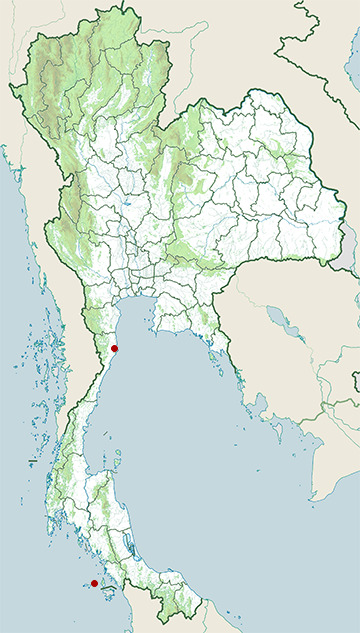
- Khao Sam Roi Yot National Park
- Tarutao National Marine Park
